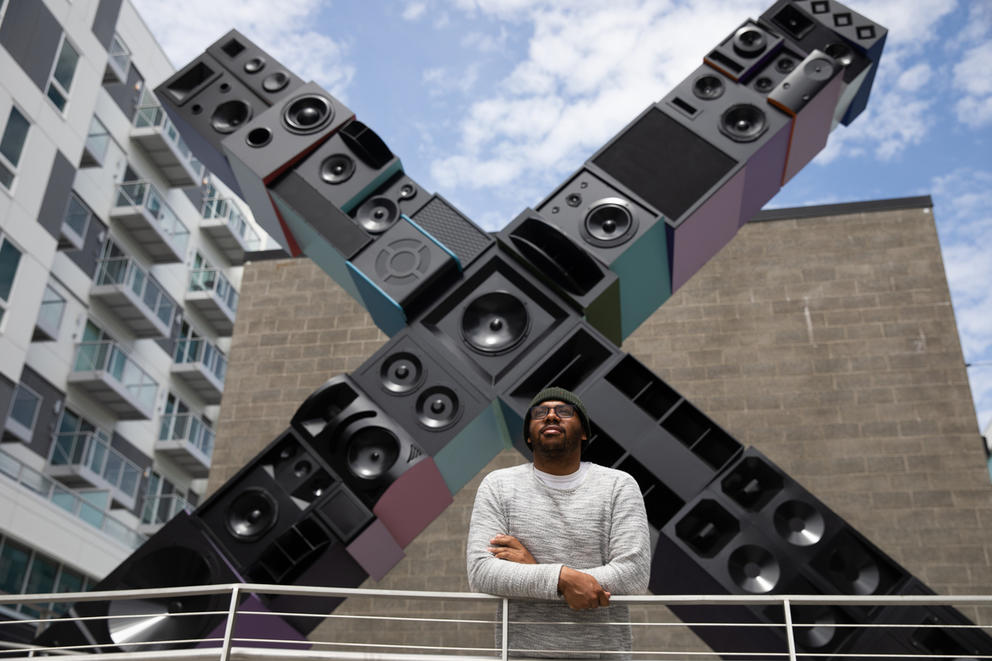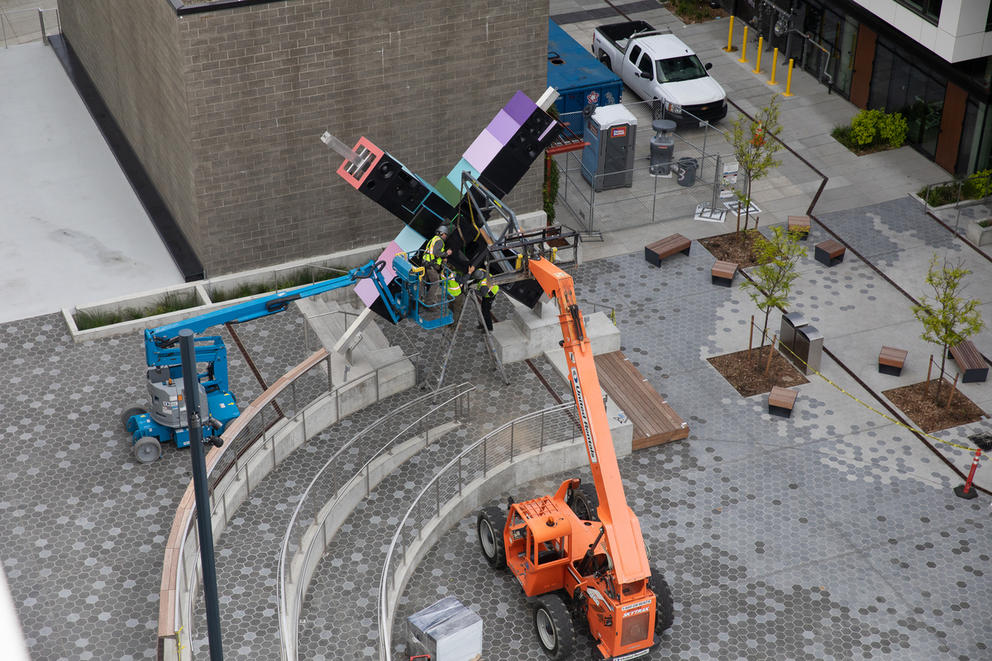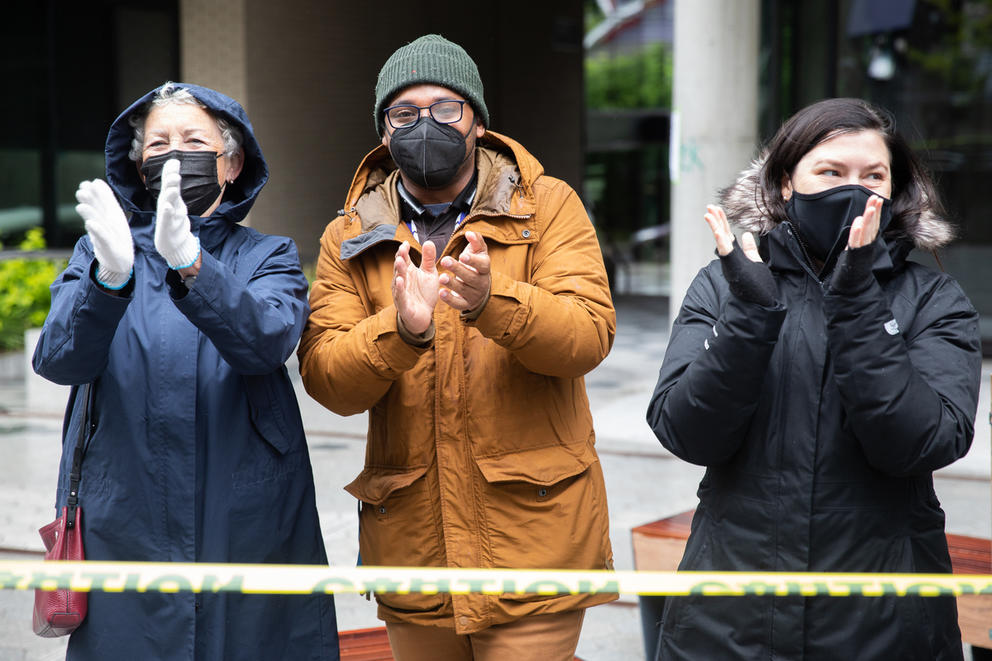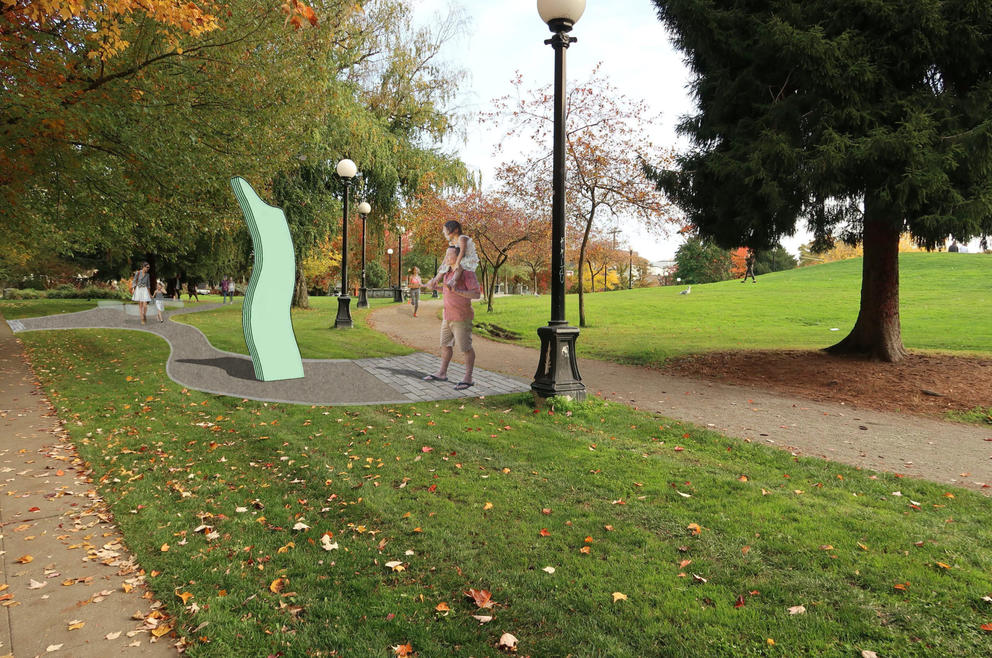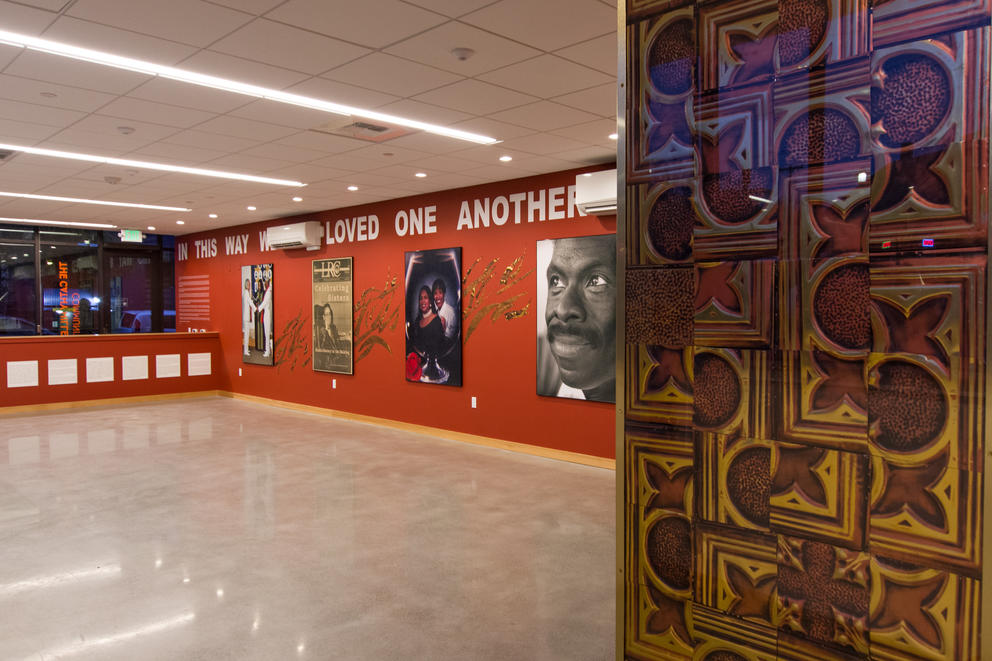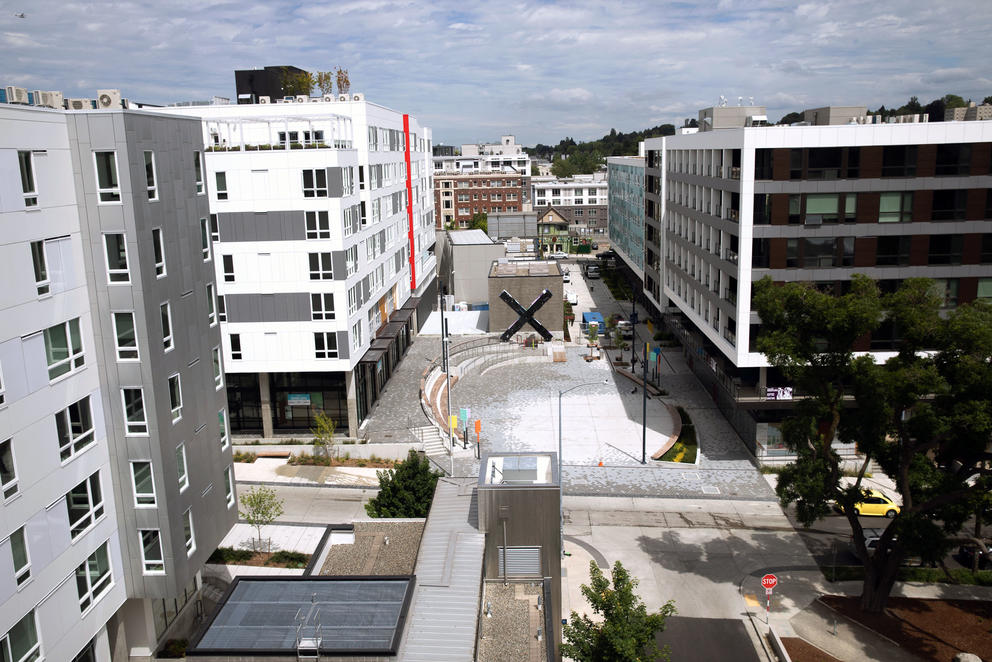As if on cue, it has begun to mizzle. A cordon of yellow caution tape shivers in the wind and tugs at the orange signposts marking the installation in progress. But Jordan, cloaked in a thick parka and a wool winter hat, seems unperturbed, holding up his phone to film the moment supreme: the seating of the bronze, aluminum and stainless steel sculpture onto a concrete base at the edge of the new ovoid plaza facing the Capitol Hill light rail station.
Titled “andimgonnamisseverybody,” the sculpture forms the centerpiece of the AIDS Memorial Pathway (AMP), a scattered trail of public artworks bridging the northwest corner of Cal Anderson Park — named after Washington state’s first openly gay state legislator, who died of AIDS-related complications in 1995 — with the new plaza, which sits between two tall new apartment developments.
When finished, the AMP will be one of the few art installations in the Pacific Northwest dedicated to memorializing the HIV/AIDS epidemic and its devastating local impact. In King County, thousands have lost their lives to HIV/AIDS since the early 1980s. Though other cities, including New York, Los Angeles, Las Vegas and San Francisco, have AIDS memorials, Seattle is one of the last major U.S. cities with a large LGBTQ+ population — which was and is especially hard hit by HIV/AIDS — to get a permanent, public and physical space for grief and remembrance.
A public dedication of the AMP is planned for June 26 — Pride weekend — though artworks will continue to be added into the summer. The yearslong process involved six artists, five government agencies and multiple private partners.
Later today, in unrelenting rain, contractors will slide the remaining components of Jordan’s X-shaped artwork — 3-foot tall metal boxes made to look like black, subwoofered speakers — over the metal legs. “Like a big shish kebab — or s’mores,” Jordan jokes. But first, the main structure has to be secured with a dozen giant, big-as-thumbs bolts.
When ready, the speakers will sound with a perpetual (if only imagined) “silent rave,” celebrating the radical hospitality and creativity — from boom box parties and ballroom to techno and disco music — of Black, brown, poor, trans, queer and other marginalized communities disproportionately impacted by the AIDS crisis. Jordan sees the X as a portal connecting generations of queer elders to today’s youth.
Today, even with the installation still in progress, its power is already palpable.
AMP project manager Jason Plourde, standing next to Jordan, is also recording the big event on his phone. When a worker fastens the bolts with a final twist, Jordan and Plourde hug in relief.
“It’s been such a long journey,” Jordan says.
The installation of Christopher Paul Jordan's sculpture “andimgonnamisseverybody” at the AIDS Memorial Pathway. The sculpture is meant to act as a portal connecting the people who did not directly experience the apex of the AIDS crisis “with those the crisis has taken away from us,” he says. (Matt M. McKnight/Crosscut)
The $2.8 million project has been six years in the making. In 2015, Tom Rasmussen, the first openly gay man on Seattle’s City Council, floated the idea of a public HIV/AIDS memorial and formed a group to look into the effort. Rasmussen visited memorials in New York, San Francisco, Paris and Sydney for inspiration. “With the exception of New York City, [the memorials] are in remote areas of the city,” he says. “I wanted Seattle’s to be as prominent and as visible and as accessible as possible.”
The AMP is arguably one of the most visible AIDS memorials in a large U.S. city, snaking around a highly trafficked light rail stop, public park and brand-new apartment developments in one of Seattle’s densest neighborhoods. The location is poignant: In the 1980s and ’90s, the HIV/AIDS crisis was deeply felt in Capitol Hill, Seattle’s LGBTQ+ epicenter at the time. In response, a major cluster of gathering spaces, services and mutual aid sprang up in the area.
The AMP and Jordan’s artwork were originally set for completion last year, but the pandemic pushed the timeline into 2021. “COVID took us for a spin,” Jordan says. “I didn’t expect for us to be trying to memorialize this pandemic from the vantage point of another one.”
The timing is extra meaningful for another reason: This June marks exactly 40 years since the first cases of what would later become known as AIDS were reported in the United States.
“Forty years, I can't believe it,” says Horatio Hung-Yan Law during a recent phone call. The Portland-based artist shaped the AMP’s art plan and also designed a series of abstract, curved and flat sculptures made out of stacked laminated glass for an installation titled “Ribbon of Light.” “I was coming out as a gay young man in the ’80s, just when the crisis started,” he says. “It was a shock to our system.”
From left, Michele Hasson, steering committee and community action group chair of the AIDS Memorial Pathway, artist Christopher Paul Jordan, and Seattle Office of Arts & Culture’s Rebecca Johnson clap as a portion of Jordan's sculpture “andimgonnamisseverybody” is installed in the central plaza at the AMP site, May 24, 2021. (Matt M. McKnight/Crosscut)
Law says he owes his art career to the AIDS epidemic. In early ’80s New York, during the first, devastating years of the epidemic, Law gave up his full-time job to get a fine arts degree. He felt that if there were ever a reason to be an artist, to make art about something life-altering, express how he felt, share anger, confusion and grief, reach into people’s hearts, the AIDS crisis was it. “It became a rallying cry for me,” he says.
“For me to be working on the AIDS Memorial at this stage of my career, 40 years later, it’s like the bookend for me,” he says. “I’m very emotional about this.”
As the lead artist overseeing the AMP’s Master Art Plan, Law sketched out a pathway dotted with various artworks and divided into thematic segments. Jordan’s work celebrates “creativity and life,” while a third work by local artist Storme Webber celebrates “resilience and community courage.” Law’s “Ribbon of Light” strikes a more somber tone as a quiet space for reflection.
After being installed later this summer, Law’s sculptures will gleam as beacons at the northern edge of Cal Anderson Park. Visitors will have to look closely to decipher the words engraved and buried in the glass layers, shimmering just below the surface: Enrage, courage, engage. Losing, releasing, forgiving. Moments, memories, stories.
From gravestones to commemorative plaques and monuments such as the Vietnam Veterans Memorial in Washington, D.C, the 9/11 memorial in New York and the AIDS memorial in Vancouver, B.C., memorials often etch the names of the dead into heavy stone or steel. Seattle’s is not a traditional memorial in this sense, though the nonprofit behind the AMP keeps “The List of Names” of Washingtonians lost to the crisis on its website.
An augmented reality app, to premiere later this year, will bring the sculptures alive with historical photos, oral history, music and a virtual artwork incorporating The List of Names. The website also serves as a historical repository of stories (in video and writing) of local community resilience, highlighting people who fought against HIV/AIDS, governmental inertia and discrimination by delivering nutritious meals, transporting people to medical appointments, setting up the first needle exchanges, testifying at city council and protesting for years.
This strong current of community courage and local activism forms a third theme of the AMP, one that weaves through the pathway in the form of rainbow-flag-hued, aluminum protest signs. Designed by local studio Civilization, the signs are debossed with messages from protest signs and slogans from the 1980s, such as, “Support, Love and Unity” and “Stop AIDS in its Tracks,” (sourced from POCAAN, People of Color Against AIDS Network campaigns) and also from more recent ACT UP protests (in bright yellow: “AIDS isn’t over”) to show that the epidemic rages on.
“Support, love and unity” echoes in a fourth artwork, housed inside a community room (which can be reserved by the public for meetings and events) in one of the new affordable housing buildings. “In this way we loved one another,” was conceived by Storme Webber, a Two-Spirit Sugpiaq/Black/Choctaw poet and interdisciplinary artist and longtime Seattleite whose artwork is dedicated to, as she puts it, “restoring absent narratives.”
Webber chose to highlight local stories of intersectional resistance and collective activism, particularly by women — such as the Rev. Gwen Hall, whose Sojourner Truth Ministries on Beacon Hill welcomed LGBTQ+ people of color and those impacted by HIV/AIDS, and outreach workers Aaliyah Messiah and Sheilah Robinson. Their stories and images are accompanied by Webber’s poignant poetry on the wine-red walls, some of which is visible from street-level windows.
“I wanted to create a space that could bring forth people who had been working deeply in community, in coalition,” Webber says. She points out that Seattle has a long history of this kind of radical activism. As a “lesbian born and raised in Capitol Hill’s gay community,” Webber says she has witnessed much of this activism herself.
“It is my hope that we will always remember what we can accomplish when we come from love,” and resistance, she says.
In the installation “And in this way we loved one another,” artist Storme Webber honors the people who “consciously stepped forward to reach out to the most excluded people affected by the HIV crisis: IV drug users, sex workers, multiply diagnosed people … Black, queer people who couldn't find a spiritual home in their own family churches,” she says. (Storme Webber/AMP) (Note: a previous photo has been replaced to show a more accurate representation of the artwork)
Jordan, too, has attempted to redress the mainstream record, arguing that the HIV/AIDS crisis has been historicized too narrowly. In 2015, he co-organized a “die-in” intervention called #StopErasingBlackPeople at the Tacoma Art Museum in response to the lack of Black artists in the museum’s exhibit Art AIDS America — flagrant, the protest organizers said, given that “the most at-risk group are currently Black trans women.” African American and Latinx people, as well as transgender women, are disproportionately affected by the HIV epidemic.
The same is true for COVID-19, which raged as Jordan finished up his AMP piece. “From having a government … working to minimize the crisis, working against public health, conspiracy theories propagating and the lack of access to reliable information for communities most impacted, it’s really felt like being put back in time,” Jordan says, adding: “The parallels don’t come from the virus…. The political reality is in parallel.”
But “andimgonnamisseverybody” — named after a line from the 1996 Bone Thugs-n-Harmony song “Tha Crossroads,” dedicated to rapper Eazy-E, who died of complications from AIDS — is about maintaining rituals of care and celebration in the face of this political reality. Jordan calls his work a “homegoing service in sculptural form.”
Resisting the binary of HIV positive or negative, he tilted the + sign, hoping to tilt the discussion about HIV from individual status and disclosure to collective health: What if we looked at the crisis with a holistic lens, understanding how intersecting identities and overlapping crises of displacement and HIV criminalization affect the most marginalized?
Artist Christopher Paul Jordan works on the fabrication of his metal boxes made to look like speakers that will emit an imagined, silent rave that doubles as a wake. Celebration, resistance and grief can go hand in hand, Jordan says. “Some of us are coming to this wake for people who we know personally and deeply, and some of us are coming for people who we didn't have the chance to meet,” he says. (Aileen Imperial/Crosscut)
The X is also a nod to indigenous African symbols, spread throughout the Western Hemisphere by enslaved people to mark passageways through the afterlife and rebirth. Jordan hopes his work can be a passageway, too, by creating “a sense of being in communion with people who aren’t here,” he says, while sitting on a large wooden bench during a second day of installation.
“We can listen and hear back the music and the vibration and the pulse of our communities across time. We can also recognize their absence through the silence,” Jordan says.
Still, he’s currently in the process of commissioning DJs across the country to make a soundtrack for use with the augmented reality app. His dream is to stage a rave on the plaza, around the artwork. Mourning and celebration, Jordan notes, are not necessarily opposing forces — particularly in many non-Western cultures.
This was true during the AIDS crisis, too, Jordan says. A vacant building could house a clandestine rave, a rave could be a reclaiming of space, a memorial, an outlet for rage, joy and sadness, a sanctuary — all at the same time. “To me, that is also a protest … and celebration,” he says, “This sense of urgency and refusal to be erased.” Jordan looks up at his giant X marking its spot here and in history, as it silently pulsates with layers of heartbeats across time. The silence is deafening.

